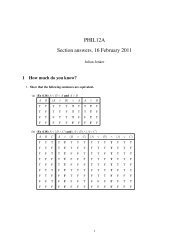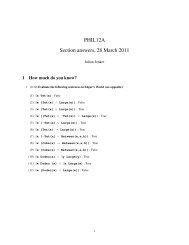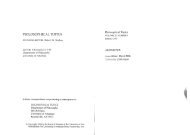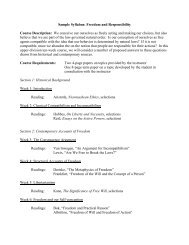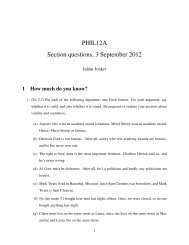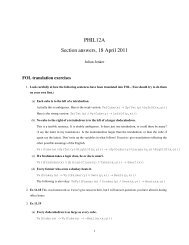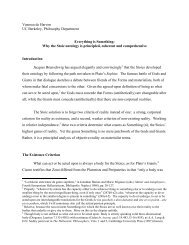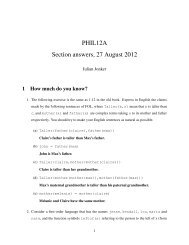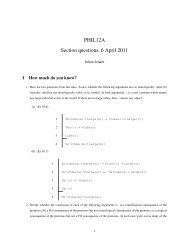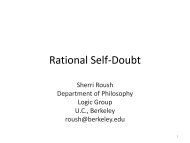PHIL12A Section answers, 14 February 2011 - Philosophy
PHIL12A Section answers, 14 February 2011 - Philosophy
PHIL12A Section answers, 14 February 2011 - Philosophy
You also want an ePaper? Increase the reach of your titles
YUMPU automatically turns print PDFs into web optimized ePapers that Google loves.
could abbreviate the sentence in the following way: ¬(P ∧ Q) ∨ R, where P stands for ‘all men are mortal’, Qstands for ‘Socrates is a man’, and R stands for ‘Socrates is mortal’. This sentence is not a tautology, as drawingup a truth table will show.The moral of the story is that our truth table method is not fine-grained enough to capture the meanings ofpredicates and names. There is logical structure embedded within the atomic sentences that cannot be capturedusing truth tables. (In fact, many logic textbooks teach logic in two stages: propositional logic, dealing onlywith complex sentences made up of atomic sentences connected by truth-functional connectives; and predicatelogic, which allows you to get into the structure of atomic sentences by working with predicates, names andquantifiers. Truth tables are taught in propositional logic, but drop out of the picture with predicate logic.)2. Name at least two sentences that are logically necessary but not tautological.For example:(a) All bachelors are unmarried men.(b) There are infinitely many prime numbers.3. Name at least two sentences that are TW-necessary but not logically necessary.For example:(a) Cube(a) ∨ Tet(a) ∨ Dodec(a)(b) (Large(a) ∧ Large(b)) ∧ ¬Adjoins(a,b)4. For each of the following, determine whether the sentence is a tautology, a logical necessity, or a TWnecessity.(a) a=b ∨ b=c ∨ c=cThis is not a necessity of any sort, though it is logically possible.(b) BackOf(a,b) ∨ ¬BackOf(a,b)This is a tautology, and therefore also a logical necessity and a TW necessity.(c) ¬(Cube(b) ∧ Cube(e)) ∨ Cube(b)A truth table shows that this is a tautology, and therefore also a logical necessity and a TW necessity.(d) ¬(Cube(b) ∧ Cube(e)) ∨ SameShape(b,e)This is a TW necessity, since in Tarski’s World there are one of two possibilities: either b and e are thesame kind of block, for example they are both tetrahedrons or they are both cubes, in which case thesentence is true; or they are different shapes. But if they are different shapes, then they are certainly notboth cubes, which means that the sentence is true.The sentence is not a tautology, as a truth table will show; however it is a logical necessity, as far as I cantell.4
(e) SameRow(a,b) ∨ ¬(FrontOf(a,b) ∨ BackOf(a,b))This is a TW necessity. Either a and b are in the same row; or it is not the case that either a is in front of bor b is in front of a. I believe this is a logical necessity; it is not a tautology.(f) SameCol(a,b) ∧ SameRow(a,b) ∧ a=bThis is not a necessity of any kind, since it is false if a and b are not in the same place. The followingwould be a TW necessity: SameCol(a,b) ∧ SameRow(a,b) ∨ ¬(a=b), but it would not be a logicalnecessity. (Why?)5. (Based on Ex 4.10) A sentence S is a logically possibility if it is true in some logically possible circumstances.S is a TW-possibility if there is at least one world that can be constructed in Tarski’s World and in whichS is true. S is a TT-possibility if at least one row of its truth table assigns True to S. Draw a set ofnested circle indicating the relationship between logical necessities, logical possibilities, TW-possibilities,TT-possibilities, and sentences which do not belong to any of these kinds. Give an example of each kindof sentence.You should have drawn three nested circles, with the innermost being the TW possibilities, the middle circlecomprising the logical possibilities, and the outer circle comprising the TT possibilities. Beyond this are thosesentences which are not TT possible, and thus not logically possible and not TW possible (sentences such asa ∧ ¬a).Here’s a TW possibility (and therefore also a logical possibility and a TT possibility): SameRow(a,b) ∧SameCol(a,b) ∧ a=b.Here’s a logical possibility (and therefore also a TT possibility) that is not a TW possibility: SameRow(a,b)∧SameCol(a,b) ∧ ¬(a=b).Here’s a TT possibility that is not a logical possibility: ¬SameRow(a,b) ∧ ¬SameCol(a,b) ∧ a=b.You might want to think about these relationships along the following lines: truth tables don’t look at thelogical structure embedded within atomic sentences, and so they simply consider what is possible in terms ofthe structure of the logical connectives. The meanings of names and predicates add additional constraints: thinkof these as the constraints placed upon logical truths by our language. The constraints narrow the sphere of TTpossibilities to the logical possibilities.The structure of the world itself then adds extra constraints on the truethings we can say about the world. These constraints narrow the sphere of the logical possibilities to the TWpossibilities.3 Challenge questions1. When determining whether a sentence is a tautology, you typically draw up a truth table and assign allpossible combinations of truth values to its atomic sentences. This is pretty laborious once you have more5
than three atomic sentences. Can you come up with a quicker way to determine whether a sentence is atautology? You should try your method with the following sentence:(¬(¬(¬(¬A ∨ B) ∨ C) ∨ D) ∨ E) ∨ (A ∨ ¬E).A tautology is true in every row of its truth table. If we try to make a tautology false, we will end up with acontradiction. On the other hand, if the sentence is not a tautology, we will end up with a valid assignment oftruth values to its atomic sentences. So let’s try this, starting with the connective that has widest scope:(¬ (¬ (¬ (¬ A ∨ B) ∨ C) ∨ D) ∨ E) ∨ (A ∨ ¬ E)FWe know that for a disjunction to be false both of its disjuncts must be false, so we now fill these in:(¬ (¬ (¬ (¬ A ∨ B) ∨ C) ∨ D) ∨ E) ∨ (A ∨ ¬ E)F F FThe disjunction on the left with the widest scope is false, so we need two false disjuncts again. On the righthand side, we have another false disjunction, allowing us to find values for A and E:(¬ (¬ (¬ (¬ A ∨ B) ∨ C) ∨ D) ∨ E) ∨ (A ∨ ¬ E)F F F F F F F TYou should see the problem immediately. We need to make E on the right hand side true, but on the left handside E comes out false. Since an atomic sentence must have the same truth value wherever it appears in acomplex sentence, we have discovered a contradiction. All this means not only that we have failed to make thesentence false, but that we cannot do so. So it is a tautology.2. The textbook says that the notion of logical necessity is ‘annoyingly vague’. Why? Can you think of asentence whose status as a logical necessity is controversial?A concept is vague if there are borderline cases which the concept does not help us to settle. Such cases mayarise for various reasons. One problem with our definition of logical necessity is its circularity. We said thata sentence is logically necessary just in case there is no logical possible circumstance in which it is false. Butnow we have based our definition of logical necessity on the notion of a logically possible circumstance, andin particular, on the notion of logical possibility. Which circumstances are logically possible? Those which arecompatible with what is logically necessary.Another problem is that there are a number of ways in which a set of circumstances can be possible or impossible.It is not possible that 2+2=5, but this kind of impossibility is not the kind of impossibility that prohibitsfaster than light speed travel. Potentially, then, our notion of necessity is ambiguous. There are further kindsof impossibility: sentences that can’t be true because of the logical relations between their words (‘There is anunmarried person who is married.’), and sentences which can’t be true because of the meanings of their words(‘There is a bachelor who is married.’) Quine famously thought that it was too difficult to come up with aprecise identification of the latter class of sentences, and that while our sentences are made true both by our6
language and the way the world is, it is not possible to sort out the contributions of language and world sentenceby sentence.Consider a sentence such as: ‘A square has four equal sides.’ This, you might venture, is not true of TahrirSquare. How can I convince you that I did not mean to include Tahrir Square amongst the things I referred to assquares? Only by saying that what I meant by ‘square’ was ‘’shape with four equal sides’. And that would bebegging the question.There is another problem with logical necessity, separate from the Quine’s doubts that we can get clear on whatit is for a sentence to be true in virtue of its meaning. For one might forego such sentences as logically necessary,and point simply to those sentences that are true in virtue of their logical structure. We know that a ∨ ¬a istautological, and thus the clearest case of a logical necessity. But we can doubt that every sentence that followsthis schema is logically necessary. ‘John has a beard or John does not have a beard’ follows the schema, buthow could we deny that there are interesting intermediate cases in which John neither has a proper beard norlacks one entirely?Or consider the schema ¬(a ∧ ¬a) - again, as clear cut a case of a logical necessity as one could possibly find.But ‘it is not the case that the particle is spin up and the particle is spin down’ is an instantiation of the schema,and quantum physics seems to tell us that such sentences are often false.There are deep problems here about what counts as a possibility, and about what counts as a possible circumstance.Formal languages, such as First Order Logic, help us make these ideas more precise, but they do notnecessarily solve the problems for natural language.7



